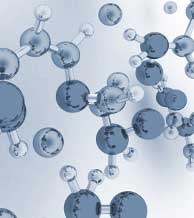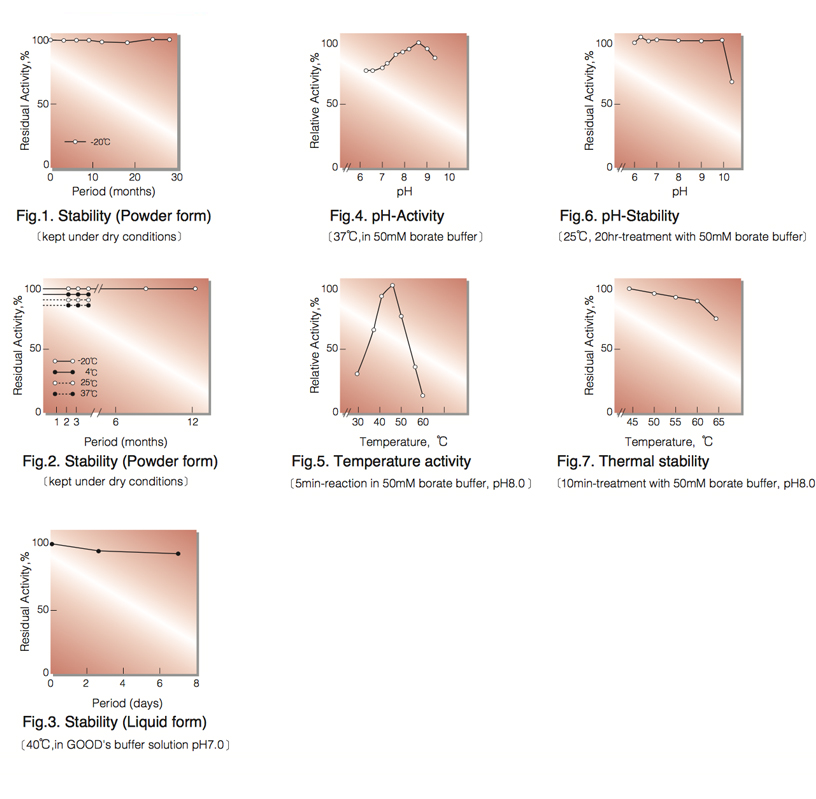XANTHINE OXIDASE from Microorganism
XTO-212
Xanthine:oxygen oxidoreductase (EC 1.1.3.22)
Hypoxanthine + O₂ + H₂O ► Xanthine + H₂O₂
Xanthine + O₂ + H₂O ► Uric acid + H₂O₂
| Appearance: | Reddish brown amorphous powder, lyophilized |
|---|---|
| Activity: | GradeⅡ 10U/mg-solid or more |
| Contaminants: | Catalase ≤5% Adenosine deaminase ≤1.0×10⁻³% Uricase ≤1.0×10⁻³% Phosphatase ≤1.0×10⁻³% Purine-nucleoside phosphorylase ≤5.0×10⁻³% |
| Stabilizers: | Sodium glutamate, BSA |
| Stability: | Stable at -20°C for at least One year (Fig.1) |
|---|---|
| Molecular weight : | approx. 160,000 |
| Isoelectric point : | 4.0±0.1 |
| Michaelis constants: | 4.5×10⁻⁵M (Xanthine) 7.6×10⁻⁵M (Hypoxanthine) |
| Inhibitors: | Reducing agents, Hg⁺⁺, Ag⁺,MIA |
| Optimum pH : | 7.5-8.0(Fig.3) |
| Optimum temperature : | 65°C(Fig.4) |
| pH Stability : | pH 6.5-9.0 (25°C, 15hr)(Fig.5) |
| Thermal stability : | below 55°C (pH 8.0, 30min)(Fig.6) |
| Substrate specificity: | (Table 1) |
| Effect of various chemicals: | (Table 2) |
APPLICATIONS
This enzyme is useful for enzymatic determination of inorganic phosphorus, 5'-nucleotidase and adenosine deaminase when coupled with Purine-nucleoside phosphorylase (PNP-311) and uricase (UAO-201, UAO-211).
ASSAY
Principle:
xanthine oxidase
Xanthine+O₂+H₂O ► Uric acid+H₂O₂
The appearance of uric acid is measured at 293nm by spectrophotometry.
Unit definition:
One unit causes the formation of one micromole of uric acid per minute under the conditions described below.
Method:
| A. Tris-HCl buffer, pH 7.5: | 0.1M |
|---|---|
| B. Sodium hydroxide solution: | 0.025M |
| C. Xanthine solution: | 10mM[Dissolve 15.2mg of xanthine (MW=152.11) in 10ml solution (B)] |
| D. Oxonic acid potassium salt : solution | 1mM (Dissolve 9.75mg of oxonic acid・K salt in 50ml H₂O) |
| E. Enzyme diluent: | 50mM Tris-HCl buffer, pH 7.5 |
Procedure
| Concentration in assay mixture | |
|---|---|
| Tris-HCl buffer | ca.89.6 mM |
| Xanthine | 0.32mM |
| Oxonic acid | 32 µM |
1. Prepare the following reaction mixture in a cuvette (d=1.0cm) and equilibrate at 37°C for about 5 minutes.
2.24ml Tris-HCl buffer, pH 7.5 (A)
0.08ml Xanthine solution (C)
0.08ml Oxonic acid solution (D)
2. Add 0.1ml of the enzyme solution* and mix by gentle inversion.
3. Record the increase in optical density at 293nm against water for 3 to 4 minutes in a spectrophotometer
thermostated at 37°C, and calculate the ΔOD per minute from the initial linear portion of the curve (ΔOD test).
At the same time, measure the blank rate (ΔOD blank) by using the same method as the test except that the enzyme diluent (E) is added instead of the enzyme solution.
* Dissolve the enzyme preparation in ice-cold enzyme diluent (E), dilute to 0.1−0.2U/ml with the same buffer and store on ice.
Calculation
Activity can be calculated by using the following formula :

ΔOD/min (ΔOD test-ΔOD blank)×Vt×df
Volume activity (U/ml) = = ΔOD/min×2.0×df
12.5×1.0×Vs
Weight activity (U/mg)=(U/ml)×1/C
- Vt
- : Total volume (2.5ml)
- Vs
- : Sample volume (0.1ml)
- 12.5
- : Millimolar extinction coefficient of uric acid under the assay condition (㎠/micromole)
- 1.0
- : Light path length (cm)
- df
- : Dilution factor
- C
- : Enzyme concentration in dissolution (c mg/ml)
| Substrate(100mM) | Relative activity |
|---|---|
| Xanthine | 100 |
| Hypoxanthine | 18.7 |
| Purine | 6.4 |
| Guanine | 18.3 |
| Adenosine | 0 |
| Chemical | Concn.(mM) | Residual activity(%) |
Chemical | Concn.(mM) | Residual activity(%) |
|---|---|---|---|---|---|
| None | − | 100 | PCMB | 2.0 | 24 |
| Metal salt |
2.0 | MIA | 2.0 | 1.1 | |
| MgCl₂ | 78 |
NaF | 2.0 | 14 | |
| CaCl₂ |
96 | NaN₃ | 20 | 25 | |
| Ba(OAc)₂ | 102 | EDTA | 5.0 | 95 | |
| FeCl₃ | 85 | o-Phenanthroline |
2.0 | 89 | |
| CoCl₂ | 100 | α,α′- Dipyridyl | 1.0 | 81 | |
| MnCl₂ | 102 | Borate | 20 | 89 | |
| ZnSO₄ | 62 | IAA | 2.0 | 24 | |
| CdCl₂ | 34 | NEM | 2.0 | 91 | |
| NiCl₂ | 91 | Triton X-100 | 0.1% | 99 | |
| CuSO₄ | 18 | Brij 35 | 0.1% | 50 | |
| PbCl₂ | 9.7 | Tween 20 | 0.1% | 106 | |
| AgCl | 0 |
Span 20 | 0.1% | 110 | |
| HgCl₂ | 1.2 | Na-cholate | 0.1% | 115 | |
| SDS |
0.05% | 111 | |||
| DAC | 0.05% | 78 |
Ac, CH₃CO; PCMB, p-Chloromercuribenzoate; MIA, Monoiodoacetate; EDTA, Ethylenediaminetetraacetate; IAA, Iodoacetamide; NEM, N-Ethylmaleimide; SDS, Sodium dodecyl sulfate; DAC, Dimethylbenzylalkylammonium chloride.
